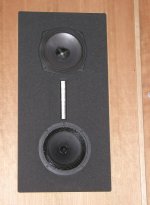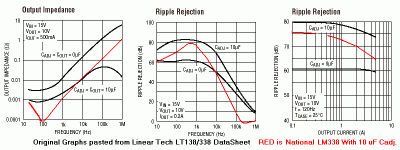😕
I've bee on the LT web site some time ago and didn't see anything better than the LT1083...
Did I miss something?

I've bee on the LT web site some time ago and didn't see anything better than the LT1083...
Did I miss something?


Specs
How about the LT1084:5A, LT1087:5A; LT1083:7.5A all max. 30 V in. Now what spec do you guys want to be beter? 😕
How about the LT1084:5A, LT1087:5A; LT1083:7.5A all max. 30 V in. Now what spec do you guys want to be beter? 😕

... But the things being said, there is the part that has lower noise than LT1083 and can supply 5A... One, not regs, and it is even by Linear not promoted by the noise figure. Fmak, how much important is it in this application? What benefits we could expect if we apply it?
LT338, Elso. The noise is 0.001% comparing to 0.003% of Vout in the case of LT1083/LT1084/LM338.
Lt338?
Hi Pedja, You mean LT338 from Linear Technology? In my datasheet noise is also 0.003 % of output voltage.😕Pedja said:LT338, Elso. The noise is 0.001% comparing to 0.003% of Vout in the case of LT1083/LT1084/LM338.
Pedja said:LT338, Elso. The noise is 0.001% comparing to 0.003% of Vout in the case of LT1083/LT1084/LM338.
I don't think noise is so important in THIS application.
That's not the point...
I wouldn't give so much attention to that spec here.
Taking into account the high PSRR of these chips and comparing to the unregulated PSU with 1000~1500uf caps, this is irrelevant.😀
carlosfm said:
I don't think noise is so important in THIS application.
That's not the point...
I wouldn't give so much attention to that spec here.
Taking into account the high PSRR of these chips and comparing to the unregulated PSU with 1000~1500uf caps, this is irrelevant.😀
Now what is relevant?
😕
NealG said:
This listening experience is at total odds to what I hear when using a regulated PSU. I don't understand it. Leo has just reconfirmed to himself of the differences as I did a few weeks ago. I have sat with Leo before and trust his opinion, his findings are the same as mine and of others who found the same when using a regulated PSU. I hope to get together with Leo and some other 'ears' I trust in the near future to compare further. BTW my reg GC is NI and not buffered yet the superiority of a regulated supply is still obvious. And please can we keep the snide remarks to ourselves.
First of all, there is no snide remarks here. In certain ways Carlos circuit is very good, but in other areas it's lacking. I noticed that certain musical cues (especially in midrange section) are better defined, but bass and resolution is not what I'm used to. The bass is boomy and lacking definition, the resolution is not there.
I'm using 400VA Plitrons with minimised GC, and those transformers are quite superior to other brands (and types) I tried. For instance, when we tried exactly the same circuit (minimized GC) with Chinese toroid it sounded very close to Carlos circuit (in bass region).
You might trust Leon's opinion, and seeing his work on the other forum, I know he is probably right. But when you look at his amp, you'll notice that he is using separate PS (and transformers) for the buffer, different buffer, and quite different parts for amp's regulator. I don't even know if he's circuit is inverting.
There is definitely possibility of sound improvement with regulators, and I'm not questioning that. What I think, the difference depends in great part by the way the circuits are implemented, both regulated and non regulated.
Pansonic FC caps are rather laid back sounding, but when used before regulators, you don't hear it, the circuit has the presence I was missing with Panasonics only. Another advantage I see here, is that one can use very good caps close to the chip, as being low in value, they'll be much more affordable (like 47u BG type N). I might try to built another regulator, but this time it would be the way I believe it should be done and with a NI GC circuit (and no buffer).
At least I'm relieved that I'm not the only one imagining things.
Luke said:
Seems strange to me, but I had the same experience with bass when I tried this a few months ago. Im quite motivated to try this layout again and use the buffer. I suspect I was imagining the lack of bass as logic would dicate bass should be better as do many people here
It certainly helps a few things but what is important is load regulation.7,5A and the TO-247 case......
A lot of discrete regulators I´ve seen used here have a rather bad load regulation and are more usable with class-a amps that have nearly constant current from the PS.
Such regulators will cause the same droops on the rails going for example from 0.1-load to 2A-load that a transformer will have and so improve nothing IMO.
A 500VA or simply "overkill" transformer will probably work better than those.
A properly implemented LM338 or anything might be a different story?
Re: Lt338?
http://www.linear.com/prod/datasheet.html?datasheet=657
Pedja
Yes Elso, I meant LT338 from Linear but note that Linear makes both LM338 and LT338. I yet have to check this better, but the only practical difference appears to be in their voltage references. LT338 is claimed to be an improved LM338.Elso Kwak said:
Hi Pedja, You mean LT338 from Linear Technology? In my datasheet noise is also 0.003 % of output voltage.😕
http://www.linear.com/prod/datasheet.html?datasheet=657
Pedja
Elso Kwak said:Now what is relevant?
😕
Comparing noise figures between regs for this application.
Peter Daniel said:The bass is boomy and lacking definition, the resolution is not there.
Absolutely not.
Would I loose my time with this?😱
First, you can try lower value resistors on the regs, this seams important.
I posted a new schematic of the PSU some pages ago.
Use around 100 ohms between Adj and Vout.
And, more important, to get a good results you need a good layout.
If not, don't bother to use the OPA627s, as they will muck up the sound.
You're looking at the wrong place.
This amp is a whole, not a bunch of bits.
as i recall it peter D's speakers are in every way much more resolving than carlos's epos boxes - that may explain alot......?
(no offence carlos - i love the epos)
(no offence carlos - i love the epos)
I have no doubts that my layout is fine.
As to the bass, it's only good untill you hear the next best thing.
As to the bass, it's only good untill you hear the next best thing.
tbla said:as i recall it peter D's speakers are in every way much more resolving than carlos's epos boxes - that may explain alot......?
(no offence carlos - i love the epos)
Peter's speakers are (probably) much more sensitive and easy to drive than my Epos.
And he complains about the bass???😕
Peter Daniel said:I have no doubts that my layout is fine.
Ok, be it.
Forget it.
And forget the 627, not for you.
You can try Pedja's buffer, Leon says it's very good.
Or remove the buffers and go back no NI, because YOU have better results with that.
LT versus LM
Hi Folks,
Apart from the differences ad stated by Pedja, I compared three graphs of the LT and LM 338 that I think are relevant.
As the PSSR of the 3875 is very good at low to med frequencies the higher frequency aspects may be most important.
From the comparison, I drew the LM curves in those from LT, you see the clear improvement of the LT except may be for the O/P impedance at low frequencies.
I think I disagree with the post of joenst where the transformer might indeed be as good as the regulator but the time inbetween when the current has to be delivered by the Caps the sag in voltage is much more than with a good regulator.
Rick
Hi Folks,
Apart from the differences ad stated by Pedja, I compared three graphs of the LT and LM 338 that I think are relevant.
As the PSSR of the 3875 is very good at low to med frequencies the higher frequency aspects may be most important.
From the comparison, I drew the LM curves in those from LT, you see the clear improvement of the LT except may be for the O/P impedance at low frequencies.
I think I disagree with the post of joenst where the transformer might indeed be as good as the regulator but the time inbetween when the current has to be delivered by the Caps the sag in voltage is much more than with a good regulator.
Rick
Attachments
- Status
- Not open for further replies.
- Home
- Amplifiers
- Chip Amps
- High-End Regulated Buffered Inverted GC

